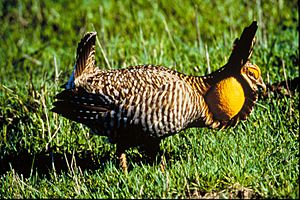Attwater's prairie chicken facts for kids
Quick facts for kids Attwater's prairie chicken |
|
|---|---|
 |
|
| Conservation status | |
| Scientific classification |
|
| Kingdom: | Animalia |
| Phylum: | Chordata |
| Class: | Aves |
| Order: | Galliformes |
| Family: | Phasianidae |
| Genus: | Tympanuchus |
| Species: | |
| Subspecies: |
T. c. attwateri
|
| Trinomial name | |
| Tympanuchus cupido attwateri Bendire, 1893
|
|
The Attwater's prairie chicken (Tympanuchus cupido attwateri) is a very rare type of bird. It is a special subspecies of the greater prairie chicken. These birds live only in the coastal grasslands of Texas and Louisiana in the United States. They are currently in great danger of disappearing forever.
Contents
What Does an Attwater's Prairie Chicken Look Like?
Attwater's prairie chickens are medium-sized birds. They are about 17 to 18 inches (43-45.5 cm) tall. They weigh about 1.5 to 2.0 pounds (0.7 to 0.9 kg). Their wings can spread out to 28 inches (70 cm). These birds have feathers with dark brown and light brown stripes. These stripes cover their back, sides, and belly.
You can tell male and female birds apart. This is called sexual dimorphism. Male birds have long feathers on their heads. These feathers stand up like ears. Males also have bright orange or golden air sacs on their necks. They puff up these sacs during their mating dances. Attwater's prairie chickens usually live for two to five years.
Where Do Attwater's Prairie Chickens Live?
These birds are native to the Western Gulf coastal grasslands. Long ago, they lived in a huge area. This area stretched from Louisiana to Texas. It covered about 6 million acres (24,000 km²).
Today, you can only find them in two main places in the wild. One is the Attwater Prairie Chicken National Wildlife Refuge. This refuge is near Eagle Lake, Texas. The other place is on private land in Goliad County, Texas.
How Do Attwater's Prairie Chickens Reproduce?
Mating Dances
Attwater's prairie chickens gather to find mates from January to mid-May. The busiest time is in mid-March. The birds meet in small groups on open, grassy areas. These special places are called "leks" or "booming grounds."
At the lek, female birds watch the males. The males try to attract females with a special dance. A male bird makes a "woo-woo" sound. This sound comes from his neck sacs as they inflate. He also struts around to impress the females. Some traditional dances of Native American Plains tribes are based on this booming display.
Nests and Chicks
In late spring, the female birds lay their eggs. They lay 10 to 14 eggs in nests on the ground. The nests are hidden in tall grass. The eggs hatch after about 26 days.
Sadly, only about 3 out of 10 eggs hatch. The other eggs are often eaten by predators. The baby chicks stay with their mother for about six weeks.
What Do Attwater's Prairie Chickens Eat?
Attwater's prairie chickens eat many different things. Their diet includes:
- Grass shoots
- Flower petals
- Seeds
- Insects like grasshoppers
Who Hunts Attwater's Prairie Chickens?
Many animals hunt these birds. Their predators include:
Young chicks can also be lost to floods.
Why Are Attwater's Prairie Chickens Endangered?
Losing Their Home
In 1900, there were about 1,000,000 Attwater's prairie chickens. Their numbers have dropped a lot. The main reason is that they have lost their natural home.
One big problem was the planting of Chinese tallow trees. These trees were planted in the early 1900s for making soap. But the Chinese tallow tree grows very fast. It takes over the native grasslands. This means there is less space for the prairie chickens. Cities growing bigger also cause habitat loss.
Because of these changes, the grasslands where these birds once lived are now small patches. These patches are also in danger. In the past, grazing animals like plains bison and natural wildfires kept the brush low. Now, the birds find it hard to move through thick plants.
Population Decline
In 1937, only about 8,700 Attwater's prairie chickens were left. In March 1967, they were put on the endangered species list. At that time, only about 1,070 birds were left in the wild. By 2003, there were fewer than 50 birds in the wild.
In 2014, about 260 birds remained. Around 100 of these lived in the wild. In 2016, heavy floods killed many eggs. The population dropped to 42 birds. Hurricane Harvey in 2017 was even worse. It likely killed at least 32 birds. Only five females were found after the hurricane.
However, in spring 2018, the wild population was estimated at 12 birds. By February 2019, the Houston Zoo had released many birds. This brought the wild population to about 200. Later that year, a count showed about 108 birds remaining.
Conservation Efforts
Many groups are working to save these birds. Captive-breeding programs are helping. These programs raise birds in safe places. Some places doing this are Fossil Rim Wildlife Center, Abilene Zoo, and Caldwell Zoo. The Houston Zoo also has a breeding flock. These birds live at the NASA Lyndon B. Johnson Space Center near Clear Lake.
Sometimes, new oil drilling projects have been allowed near breeding grounds. This can disturb the birds and their habitat. Environmental groups are concerned about drilling in these sensitive areas.
Images for kids
See also
 In Spanish: Tympanuchus cupido attwateri para niños
In Spanish: Tympanuchus cupido attwateri para niños




